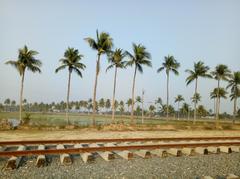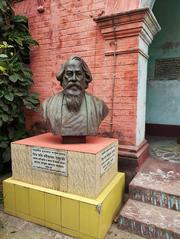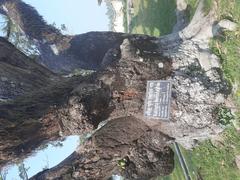
Comprehensive Guide to Visiting Pabna Sadar Upazila, Pabna District, Bangladesh
Date: 13/08/2024
Captivating Introduction
Welcome to Pabna Sadar Upazila, a mesmerizing blend of history, culture, and natural beauty nestled in the heart of Bangladesh. Imagine wandering through ancient kingdoms, witnessing the grandeur of Mughal architecture, and feeling the resilience of a people who have withstood the tests of time. This region, once part of the illustrious Pundra kingdom, beckons you to traverse its storied past and vibrant present (Holly Melody).
Pabna Sadar Upazila is a living museum where each era has left its indelible mark. From the bustling bazaars of the Mughal period to the British colonial bridges that whisper tales of rebellion, every corner of this district tells a story (Trip.com, Wikipedia). The echoes of the 1971 Liberation War resonate through its memorial sites, while the post-independence boom has transformed it into a hub of agricultural prosperity and cultural richness (Prothom Blog).
But Pabna Sadar Upazila is not just about history. It is a sensory feast, where the aroma of local biryanis mingles with the soulful tunes of Baul singers, and where the vibrant colors of Nakshi Kantha quilts reflect the region’s artistic soul (The Daily Star). Whether you’re a history buff, a nature lover, or a cultural enthusiast, Pabna Sadar Upazila promises an unforgettable journey through time and tradition. So pack your bags and get ready to uncover the hidden gems of this enchanting upazila!
Table of Contents
- [Historical Significance of Pabna Sadar Upazila](#historical-significance-of-pabna-sadar-upazila)
- [Ancient Civilizations and Early History](#ancient-civilizations-and-early-history)
- [Mughal Era Marvels](#mughal-era-marvels)
- [British Colonial Period: Rebellion and Resilience](#british-colonial-period-rebellion-and-resilience)
- [Liberation War of 1971: A Battlefield of Bravery](#liberation-war-of-1971-a-battlefield-of-bravery)
- [Post-Independence Development: A Blossoming Economy](#post-independence-development-a-blossoming-economy)
- [Architectural Landmarks: Echoes of the Past](#architectural-landmarks-echoes-of-the-past)
- [Cultural Heritage: Craft and Melody](#cultural-heritage-craft-and-melody)
- [Visitor Tips](#visitor-tips)
- [Getting There](#getting-there)
- [Accommodation](#accommodation)
- [Local Transportation](#local-transportation)
- [Key Attractions](#key-attractions)
- [Hardinge Bridge](#hardinge-bridge)
- [Pabna Edward College](#pabna-edward-college)
- [Chalan Beel](#chalan-beel)
- [Cultural Insights](#cultural-insights)
- [Local Festivals](#local-festivals)
- [Safety Tips](#safety-tips)
- [Health and Wellness](#health-and-wellness)
- [Local Cuisine](#local-cuisine)
- [Shopping](#shopping)
- [Communication](#communication)
- [Environmental Responsibility](#environmental-responsibility)
- [Emergency Contacts](#emergency-contacts)
- [Call to Action](#call-to-action)
Historical Significance of Pabna Sadar Upazila
Ancient Civilizations and Early History
Thousands of years ago, Pabna Sadar Upazila was a thriving part of the Pundra kingdom, with its capital at Mahasthangarh. Archaeological findings have unearthed relics that speak of a civilization rich in culture and heritage. During the Maurya and Gupta dynasties in the 4th and 5th centuries, and later under the Pala and Sena dynasties, this region was a significant hub of activity (Holly Melody).
Mughal Era Marvels
Fast forward to the Mughal era, when Pabna Sadar Upazila flourished as a center of commerce and culture. The Hazir Hat Jame Mosque, with its intricate designs, stands as a testament to the architectural brilliance of that era (Trip.com).
British Colonial Period: Rebellion and Resilience
The British colonial period added another layer of drama to Pabna Sadar Upazila’s history. The Indigo Revolt of 1859-1860 saw local farmers rise against oppressive British indigo planters. The Pabna Disturbances further highlighted the indomitable spirit of the locals as they fought for agrarian rights (Wikipedia).
Liberation War of 1971: A Battlefield of Bravery
During the Bangladesh Liberation War in 1971, Pabna Sadar Upazila was a stage for numerous battles. The bravery of its people is immortalized in memorial sites and war cemeteries scattered across the district (Holly Melody).
Post-Independence Development: A Blossoming Economy
After the partition of India in 1947, Pabna became part of East Pakistan, and later, Bangladesh in 1971. The post-independence period saw rapid urbanization and infrastructural development. The region’s economy thrives on agriculture, with lush rice fields, mango orchards, and jute production (Prothom Blog).
Architectural Landmarks: Echoes of the Past
Pabna Sadar Upazila is a treasure trove of architectural landmarks. The Pabna Rajbari, once home to local zamindars during the British era, stands as a grand reminder of opulence. Its European-influenced architecture is a sight to behold (Holly Melody). The Chatmohar Shahi Mosque, built in 1582 AD, showcases the Sultanate influence and remains one of the earliest shrines of Mughal Bengal (The Daily Star).
Cultural Heritage: Craft and Melody
Beyond history, Pabna Sadar Upazila is a vibrant cultural hub. Artisans here create traditional Nakshi Kantha quilts, offering a tangible connection to the past. Baul singers, with their mystical lyrics and soulful tunes, mesmerize both locals and tourists. The region celebrates its literary legends and cultural icons through festivals and artistic expressions (Holly Melody).
Visitor Tips
Getting There
Pabna Sadar Upazila is well-connected by road and rail, making it accessible from major cities in Bangladesh. The Ishwardi Railway Junction, one of the most significant railway hubs in the country, is located nearby and offers regular train services to and from Dhaka, Rajshahi, and other major cities (Banglapedia). For those preferring road travel, several bus services operate daily routes to Pabna from Dhaka, Rajshahi, and other regional centers.
Accommodation
Pabna Sadar offers a range of accommodation options to suit different budgets and preferences. From budget guesthouses to mid-range hotels, visitors can find suitable lodging. Some notable options include the Hotel Pabna Inn and the Ishwardi Hotel. It is advisable to book accommodations in advance, especially during peak tourist seasons or local festivals.
Local Transportation
Getting around Pabna Sadar is easy with rickshaws and auto-rickshaws being the most popular modes of transport. For longer trips within the upazila or to nearby attractions, renting a car or using local bus services is recommended. Ensure to negotiate fares beforehand when using rickshaws or auto-rickshaws to avoid any misunderstandings.
Key Attractions
Hardinge Bridge
One of the most iconic landmarks in Pabna Sadar is the Hardinge Bridge, a steel railway bridge over the Padma River. Built during the British colonial period, it is an engineering marvel and offers picturesque views of the river (Banglapedia). Visitors can walk along the bridge and enjoy the scenic beauty, especially during sunrise or sunset.
Pabna Edward College
Established in 1898, Pabna Edward College is one of the oldest and most prestigious educational institutions in the region. The college campus, with its historic buildings and lush greenery, is worth a visit for those interested in colonial architecture and educational history (Banglapedia).
Chalan Beel
Chalan Beel, a large wetland area, is another must-visit attraction. It is a haven for bird watchers and nature enthusiasts, offering opportunities to see various species of birds and aquatic life. Boat rides are available, providing a unique way to explore the beel and its surroundings.
Cultural Insights
Pabna Sadar is rich in cultural heritage, with a vibrant mix of traditions and practices. The district is known for its folk culture, including various forms of folk songs such as Dhua, Barase, Jari, and Sari (Banglapedia). Visitors can experience these cultural expressions during local festivals and events.
Local Festivals
Participating in local festivals can provide a deeper understanding of the region’s culture. Some notable festivals include the Bengali New Year (Pohela Boishakh) and various religious festivals celebrated by the Muslim and Hindu communities. These events often feature traditional music, dance, and food, offering a rich cultural experience.
Safety Tips
While Pabna Sadar is generally safe for tourists, it is always advisable to take standard precautions. Keep your belongings secure, especially in crowded places. It is also recommended to avoid traveling alone at night and to use reputable transportation services.
Health and Wellness
Ensure you have travel insurance that covers health emergencies. There are several hospitals and clinics in Pabna Sadar, including the Pabna Medical College Hospital, which provides adequate medical services. It is also advisable to carry basic medications and a first-aid kit.
Local Cuisine
Exploring local cuisine is a delightful part of visiting Pabna Sadar. The region is known for its traditional Bengali dishes, including rice, fish curry, and various lentil preparations. Street food is also popular, with items like pithas (rice cakes) and jhalmuri (spicy puffed rice) being local favorites. Some recommended places to try local food include the Pabna Bazar area and various local eateries.
Shopping
For those interested in shopping, Pabna Sadar offers a variety of options. The local markets are great places to buy traditional handicrafts, textiles, and souvenirs. The Pabna Bazar is particularly popular for its wide range of goods, from clothing to household items.
Communication
While Bengali is the primary language spoken in Pabna Sadar, many people, especially in the service industry, understand and speak basic English. Learning a few common Bengali phrases can enhance your travel experience and help in better communication with locals.
Environmental Responsibility
Visitors are encouraged to be environmentally responsible. Avoid littering and use designated waste disposal facilities. Participating in local conservation efforts, such as tree planting or clean-up drives, can also be a rewarding experience.
Emergency Contacts
It is essential to have a list of emergency contacts handy. The local police station, hospital, and your country’s embassy or consulate in Bangladesh should be on this list. The local emergency number for police is 999.
Call to Action
Ready to uncover Pabna Sadar’s secrets? Download Audiala for expertly crafted audio guides that turn your visit into an unforgettable adventure. Explore, learn, and enjoy with Audiala, your ultimate travel companion!
Conclusion
As you conclude your journey through Pabna Sadar Upazila, it’s clear that this region is a treasure trove of historical wonders, cultural heritage, and natural beauty. From ancient civilizations that once thrived under the Pundra kingdom to the architectural marvels of the Mughal and colonial eras, Pabna Sadar Upazila offers a rich tapestry of experiences that captivate the mind and soul.
The resilience of its people, showcased during the Indigo Revolt and the Liberation War of 1971, is a testament to the indomitable spirit that defines this district. The post-independence era has seen Pabna Sadar Upazila flourish, with its economy thriving on agriculture and its culture celebrated through various festivals and artistic expressions.
As you immerse yourself in the local cuisine, explore the bustling markets, and engage with the vibrant traditions, you’ll find that Pabna Sadar Upazila is more than just a destination—it’s an experience that stays with you long after you’ve left. So why wait? Download Audiala, your ultimate travel companion, and unlock the secrets and stories of Pabna Sadar Upazila. Let Audiala guide you through this enchanting region, offering expert insights and hidden gems that make your journey truly unforgettable. Your adventure awaits!


